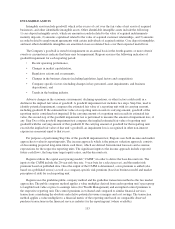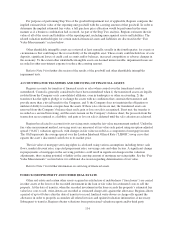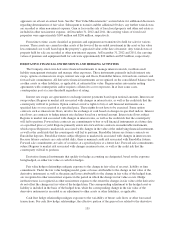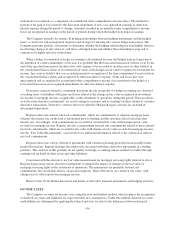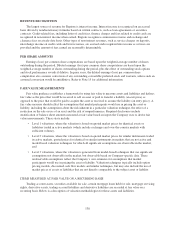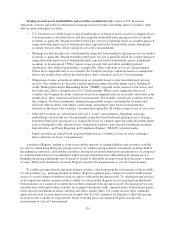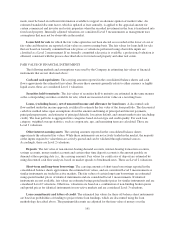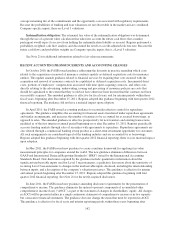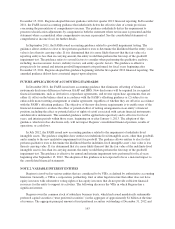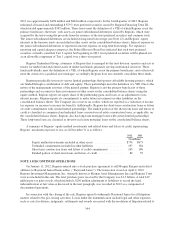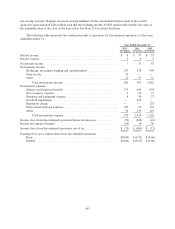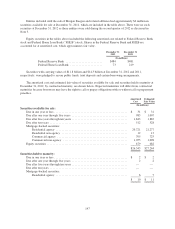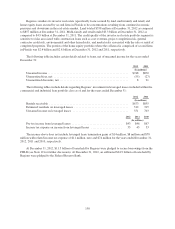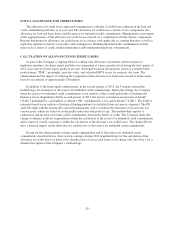Regions Bank 2012 Annual Report Download - page 159
Download and view the complete annual report
Please find page 159 of the 2012 Regions Bank annual report below. You can navigate through the pages in the report by either clicking on the pages listed below, or by using the keyword search tool below to find specific information within the annual report.December 15, 2011. Regions adopted this new guidance with first quarter 2012 financial reporting. In December
2011, the FASB issued accounting guidance that indefinitely defers the effective date of certain provisions
concerning the presentation of comprehensive income. The guidance indefinitely defers the requirement to
present reclassification adjustments by component in both the statement where net income is presented and the
statement where accumulated other comprehensive income is presented. See the consolidated statements of
comprehensive income (loss) for further details.
In September 2011, the FASB issued accounting guidance related to goodwill impairment testing. The
guidance allows entities to elect to first perform qualitative tests to determine the likelihood that the entity’s fair
value is less than its carrying value. If it is determined that it is more likely than not that the fair value of a
reporting entity is less than its carrying amount, the entity would then perform the first step of the goodwill
impairment test. The guidance refers to several factors to consider when performing the qualitative analysis,
including: macroeconomic factors, industry factors, and entity-specific factors. The guidance is effective
prospectively for annual and interim goodwill impairment tests performed for fiscal years beginning after
December 15, 2011. Regions adopted this guidance beginning with the first quarter 2012 financial reporting. The
amended guidance did not have a material impact upon adoption.
FUTURE APPLICATION OF ACCOUNTING STANDARDS
In December 2011, the FASB issued new accounting guidance that eliminates offsetting of financial
instruments disclosure differences between GAAP and IFRS. New disclosures will be required for recognized
financial instruments, such as derivatives, repurchase agreements, and reverse repurchase agreements, that are
either (1) offset on the balance sheet in accordance with the FASB’s offsetting guidance or (2) subject to an
enforceable master netting arrangement or similar agreement, regardless of whether they are offset in accordance
with the FASB’s offsetting guidance. The objective of the new disclosure requirements is to enable users of the
financial statements to evaluate the effect or potential effect of netting arrangements on an entity’s financial
position, including the effect or potential effect of rights of setoff associated with certain financial instruments
and derivative instruments. This amended guidance will be applied retrospectively and is effective for fiscal
years, and interim periods within those years, beginning on or after January 1, 2013. The adoption of this
guidance, which involves disclosure only, will not impact Regions’ consolidated financial position, results of
operations, or cash flows.
In July 2012, the FASB issued new accounting guidance related to the impairment of indefinite-lived
intangible assets. The guidance simplifies how entities test indefinite-lived intangible assets, other than goodwill,
and is similar to the new qualitative impairment test for goodwill. The guidance allows entities to elect to first
perform qualitative tests to determine the likelihood that the indefinite-lived intangible asset’s fair value is less
than its carrying value. If it is determined that it is more likely than not that the fair value of the indefinite-lived
intangible asset is less than its carrying amount, the entity would then perform the first step of the goodwill
impairment test. The guidance is effective for annual and interim impairment tests performed for fiscal years
beginning after September 15, 2012. The adoption of this guidance is not expected to have a material impact to
the consolidated financial statements.
NOTE 2. VARIABLE INTEREST ENTITIES
Regions is involved in various entities that are considered to be VIEs, as defined by authoritative accounting
literature. Generally, a VIE is a corporation, partnership, trust or other legal structure that either does not have
equity investors with substantive voting rights or has equity investors that do not provide sufficient financial
resources for the entity to support its activities. The following discusses the VIEs in which Regions has a
significant interest.
Regions owns the common stock of subsidiary business trusts, which had issued mandatorily redeemable
preferred capital securities (“trust preferred securities”) in the aggregate of approximately $1 billion at the time
of issuance. The aggregate principal amount of trust preferred securities outstanding at December 31, 2012 and
143


